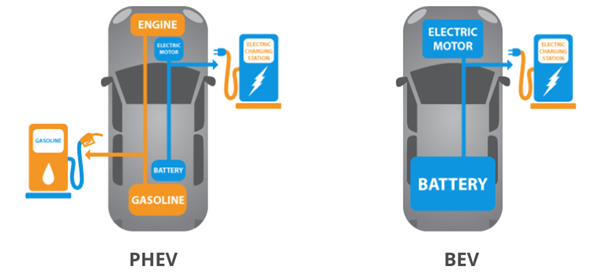The main difference between battery-electric vehicles (BEVs) and plug-in electric vehicles (PHEVs) is battery battery-electric vehicles are fully electric vehicles and do not have an internal combustion engine, while plug-in electric vehicles are a combination of both electric and internal combustion engines.
Following are some differences between battery electric vehicles and plug-in electric vehicles.
Working Principle
Battery electric vehicle
Battery electric vehicles are fully electric vehicles that run fully on-board battery packs. Battery electric vehicles use 100% electric energy.
Plug-in electric vehicle
Plug-in electric vehicles are a combination of both electric and internal combustion engines. They use about 50% electric energy.
The batteries are used for shorter distances or in urban areas, while internal combustion is used when batteries get depleted. They are also used in combination to achieve good efficiency.
Design and Construction
Battery electric vehicle
These vehicles are designed for cities and urban areas. They are lighter in weight as compared to the plug-in electric vehicles as they don’t need rigid design.
Plug-in electric vehicle
Plug-in electric vehicles are designed to travel for both purposes city and long distances. They are heavier than battery electric as they have both electric motors and internal combustion engines.
Battery
Battery electric vehicle
This battery pack is recharged and reused that why it is called a regenerative battery pack. These are lithium-ion batteries.
Plug-in electric vehicle
A plug-in hybrid electric vehicle uses a high-capacity battery. This is a rechargeable battery and stores electric energy that can be used later.
Driving Experience and Performance
Battery electric vehicle
Additionally, EVs can offer competitive performance, with some high-end models achieving impressive acceleration and top speeds.
Electric vehicles are known for their instant torque and smooth acceleration, providing a unique driving experience.
Plug-in electric vehicles
The performance of plug-in electric vehicles is good in long-drive trips. They can carry more load while climbing hills as they have internal combustion engines.
Drive range and refueling and recharging
Battery electric vehicle
The driving range of battery electric vehicles is 450 km (280 miles). It also depends on the battery pack capacity. Batteries can be charged at charging stations also on household electric supply.
Plug-in electric vehicle
Plug-in electric vehicles can be charged as battery electric vehicles also they can be refueled at fuel stations, this makes plug-in electric vehicles more flexible and more versatile for longer trips.
Efficiency
Battery electric vehicle
Electric motors used in EVs are highly efficient, converting a large portion of the energy from the battery into forward motion.
The battery electric is more energy efficient than plug-in electric vehicles as there are no mechanical elements.
Plug-in electric vehicle
The efficiency of plug-in electric vehicles depends on the driving situation. They provide better efficiency in long trips where they use internal combustion engines as power sources. Also, they are more efficient in stop-and-go traffic situations.
Maintenance and operating costs
Battery electric vehicle
However, battery replacement costs for EVs should be considered in the long term and there are lower mechanical elements that require lower maintenance costs to operate vehicles.
Plug-in electric vehicle
Due to mechanical and electrical systems on board in plug-in vehicles they required more maintenance and operation cost.
Environmental impacts
Battery electric vehicle
Electric vehicles are more eco-friendly operation vehicles as they are fully operated on electrical energy sources.
Zero tailpipe gas emission in battery electric vehicles. The overall impact depends on how the battery electric vehicles are charged.
Plug-in electric vehicle
Plug-in electric vehicles produce emissions when operating in hybrid mode using the internal combustion engine.
The environmental impact is generally lower when operating in electric-only mode, but it still depends on the energy sources used for electricity and the efficiency of the internal combustion engine.
Charging infrastructure
Battery electric vehicle
Electric vehicles are more eco-friendly operation vehicles as they are fully operated on electrical energy sources.
Zero tailpipe gas emission in battery electric vehicles. The overall impact depends on how the battery electric vehicles are charged.
Plug-in electric vehicle
Plug-in electric vehicles are not dependent on charging stations as they can be alternatively powered by fuel. This improves the travel range of vehicles.
Upfront cost
Battery electric vehicle
Battery electric vehicles may have a higher upfront cost due to the expense of the battery.
Plug-in electric vehicle
Plug-in electric vehicles might be more affordable initially, but long-term operating costs could be higher.
